Excerpts from Jim Conrad's
Naturalist Newsletter
Entry issued on June 9, 2019, from Tepakán, Yucatán, MÉXICO
YUCATAN SPINY LIZARD JUVENILE UP CLOSE
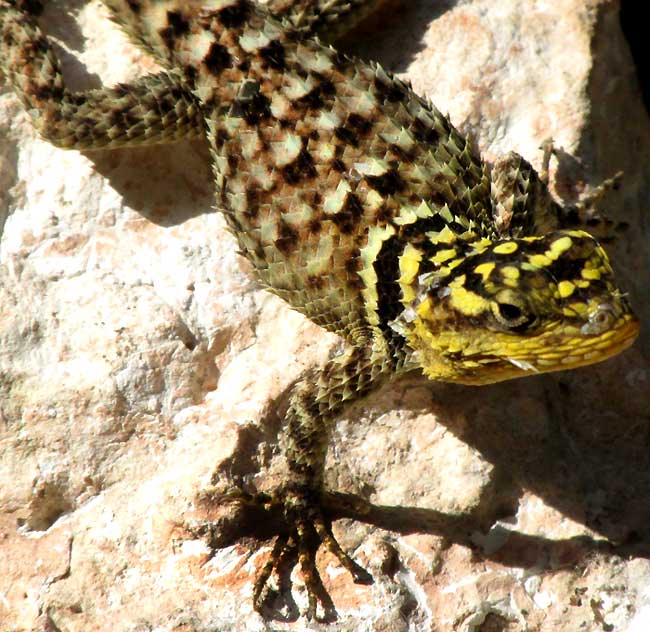
A benefit to living in a little stone hut on an isolated rancho reverting to forest is that the animals get used to you and you can see them better. Upon my arrival, I was delighted when an immature Yucatan Spiny Lizard one morning scampered across the outside kitchen's concrete floor, permitting a picture
Most mornings nowadays possibly the same little lizard hangs around my morning-sun-basking/ granola-eating spot like a pet dog. That's him atop this page. One reason his colors are so bright may be that he's just shed his "skin," white tatters of which still cling around his mouth.
Entry issued on May 30, 2019, from Tepakán, Yucatán, MÉXICO
YUCATAN SPINY LIZARDS
A lizard with colors and patterns I'd never seen before scampered across the concrete patio of the rock hut's outside kitchen. You can see it below:
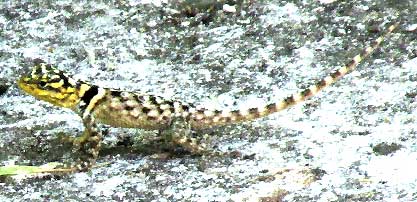
With the bold black-and-white collar and banded tail at first I thought it was the Yucatan Banded Gecko but then the shape wasn't quite right, and the facial pattern was wrong. Eventually the visitor proved to be a juvenile Yucatan Spiny Lizard, SCELOPORUS SERRIFER ssp. SERRIFER. The identification was helped along when later a pair of adults with black collars turned up basking on the vertical wall of the stone hut, shown at below:
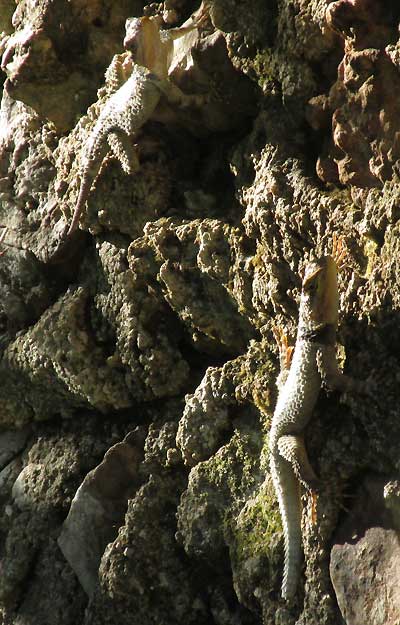
A close-up better showing one of those adult's spines appears below:
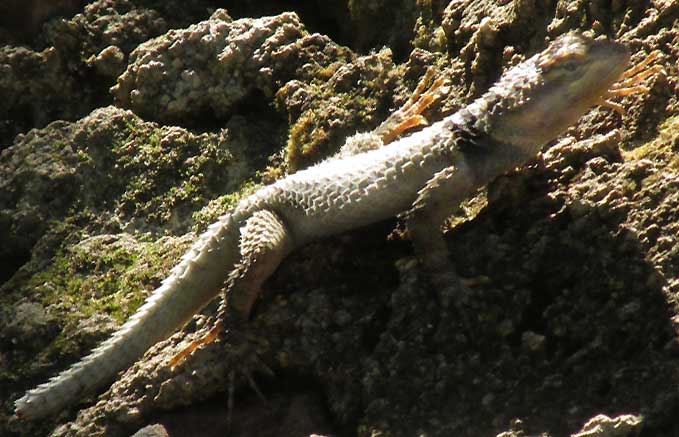
We've seen this species before, down in Chiapas, where it displayed different coloration {see below}. That probably was Sceloporus serrifer ssp prezygus, known as the Chiapan Rough-scaled Lizard, though the species' taxonomy is in a mess and changing all the time. The species is distributed from Texas throughout Mexico into Guatemala and Belize.
from the November 12, 2007 Newsletter issued from Yerba Buena Clinic just outside Pueblo Nuevo Solistahuacan, Chiapas, MÉXICO
about 1740 meters in elevation, ± LAT. 17° 11' 27"N, LONG. -92° 53' 35"W
A WINDOW-SITTING SPINY LIZARD
Last Thursday was the first really sunny day we've had since the flooding and it sure was wonderful. At these elevations and at this season sunny days are cool and crisp, and the sky couldn't be bluer. By "cool" I mean it was 48° at dawn and in the mid sixties during the afternoon.
Wandering the grounds looking for butterflies to photograph I turned the corner of an abandoned building ornamented with invader slogans and surprised a 10-inch long lizard enjoying the sun as much as I. He scrambled up the wall and I was sure he'd get away before I could get my camera set, but he made the mistake of trying to get through a window's pane of glass. As he spun his wheels I managed to snap the picture shown below.
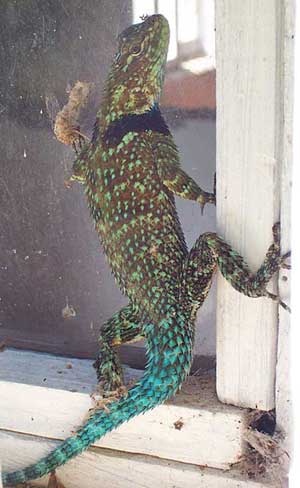
With that blue collar around his neck he reminded me of the Mountain Spiny Lizard, Sceloporus jarrovi, we saw back in the Querétaro highlands, whose picture remains at www.backyardnature.net/n/07/070428ly.jpg.
That seems a smaller, less robust species than my window sitter. Window Sitter clearly belongs to the genus Sceloporus, however, and in English we'd call him a spiny lizard. The only Sceloporus listed for the Reserve is Sceloporus taeniocnemis, and I suspect that the list maker had in mind this species, especially because he remarks that the species is common around dwellings.
However, Sceloporus classification is in a mess. Window-sitter looks very much like the common, widely distributed Blue-spotted Spiny Lizards that basked on stone walls back in the Yucatan and I read that in the highlands of Guatemala that species occurs to 2,300 meters in elevation. Therefore, until I learn better, I'll be thinking of Window Sitter as belonging to one of several local subspecies of the Blue-spotted Spiny Lizard, SCELOPORUS SERRIFER